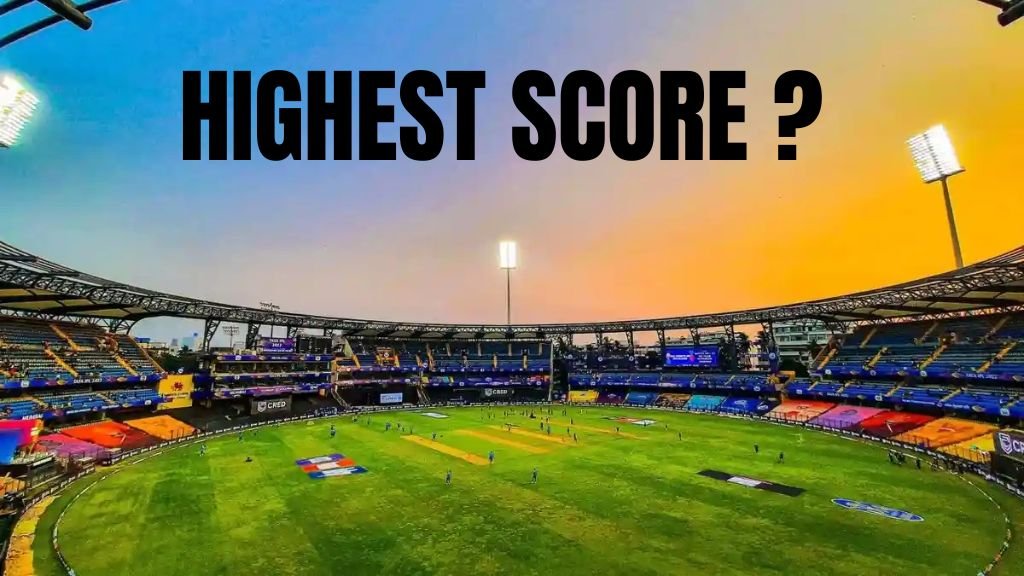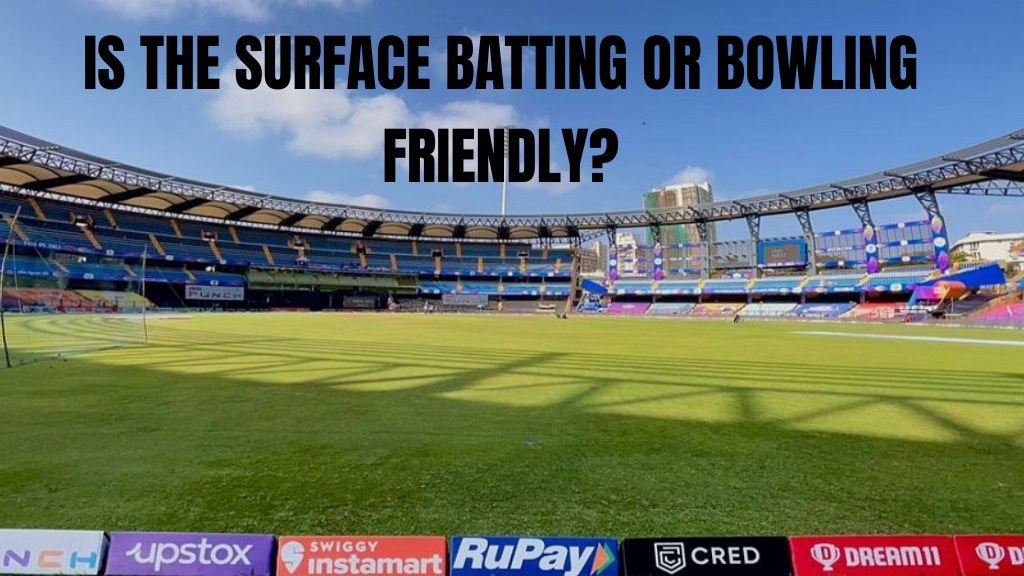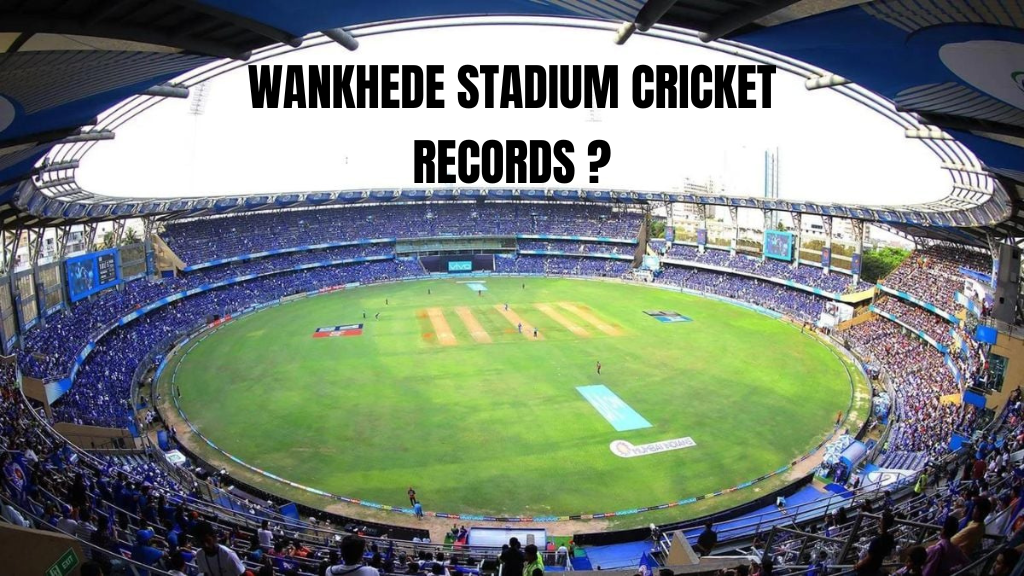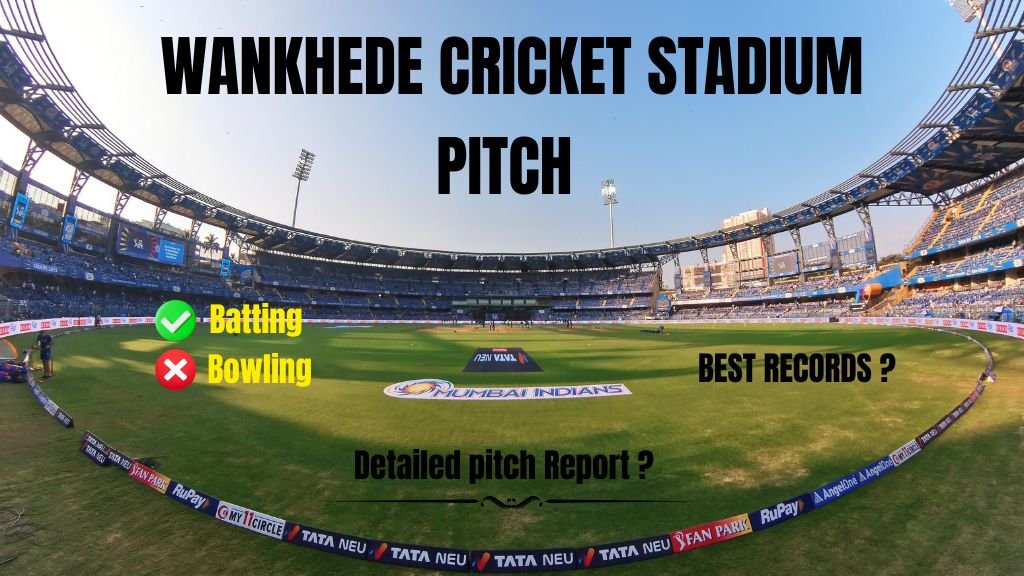Wankhede cricket stadium pitch report– The iconic Wankhede Stadium in Mumbai, a cricket landmark since 1974. Nestled by the Arabian Sea in South Mumbai, Wankhede Stadium (S.K. Wankhede Stadium) is one of India’s most storied cricket grounds. Built in 1974 after a dispute between Mumbai cricket authorities and the Cricket Club of India, it opened with a 45,000-seat capacity. Wankhede cemented its place in history by hosting India’s unforgettable 2011 World Cup Final (Dhoni’s famous six) and Sachin Tendulkar’s final Test in 2013. Over five decades, it has witnessed numerous historic feats – Sunil Gavaskar’s 205 (1979) and Vinod Kambli’s 224 (1993) are iconic batting records here, while Ravi Shastri’s six sixes over Tilak Raj (1985) and Ian Botham’s all-round century-plus-13 wickets in 1980 exemplify its rich legacy. Today Wankhede blends historic charm with modern design: renovated extensively for the 2011 World Cup (adding bucket seating, upgraded stands, and improved facilities).
- Location: Mumbai (Churchgate), Maharashtra, India
- Established: 1974
- Capacity: ~32,000 (post-2011 renovation)
- Ends: Garware Pavilion End, Tata End
- Floodlights: Yes (upgraded for night matches)
- Home Teams: Mumbai (domestic), Mumbai Indians (IPL), India national team home venue
- Pitch: Red-soil core, grass outfield (noted for consistent bounce)
- Local Time: 00:42, Sat May 24, 2025 (Asia/Kolkata)

History and Architecture
Wankhede Stadium was named after S.K. Wankhede, a former cricket administrator and politician, and was purpose-built by the Mumbai Cricket Association (MCA) in 1974. The inaugural Test came in Jan 1975 (India vs West Indies) where Clive Lloyd scored an unbeaten 242. The first Indian win here was against New Zealand two seasons later. For years it stood as Mumbai’s primary ground alongside the Brabourne Stadium.
Renovation and Features
Major redevelopment took place before the 2011 ICC World Cup, as Mumbai was chosen to host the final. Architects PK Das and Shashi Prabhu revamped the North and South ends, adding modern bucket seating, many new toilets, and food courts for spectator comfort. Notably, Wankhede features cantilevered roofs – Teflon-fabric canopies without supporting columns – which provide shade without obstructed views. These roofs also include exhaust fans that help ventilate the stands by drawing out hot air and allowing the sea breeze to flow in. The complete renovation reduced capacity from ~39,000 to about 33,100 (closer to the often-cited 32,000). Floodlights were also upgraded (a ₹6-crore project) to meet ICC lux standards, ensuring bright, uniform lighting for day-night matches.
Stand Names
The stadium honors cricket legends through its stand names. The main stands include Sunil Gavaskar Stand, Sachin Tendulkar Stand, Rohit Sharma Stand, Vijay Merchant Stand, MCA Stand (Mumbai Cricket Association), Sharad Pawar Stand, Garware Stand, North Stand, and Grand Stand. For example, the Gavaskar, Tendulkar and Merchant stands pay tribute to three of India’s finest batsmen. Each stand offers a different perspective on the action, but thanks to the cantilever design, views are generally unobstructed from all levels.
Interior view of Wankhede Stadium, showing the multi-tier stands and iconic roof structure.
Wankhede Cricket Stadium Pitch Report
Wankhede cricket stadium pitch report Wankhede’s pitch is famed for consistent bounce and batting friendliness, largely due to its local red-soil composition. However, conditions can vary by format and over time:
- Tests: The Wankhede Test track tends to start as a good batting wicket, with even bounce for strokeplay. Over five days, it often breaks down and offers turn; spinners have thrived in late sessions (for instance, India’s bowlers drew sharp turn in the 2005 Test vs Australia, leading to a sub-250 second innings and a 3-day finish). Initially, the sea breeze through the open ends gives early-swing bowlers an edge, but this impact was muted somewhat after 2011’s roofing and exhaust fans were installed. Famous examples include the “Jubilee Test” (1980) where both swing and spin were on display (Ian Botham took 13 wickets and a century). Overall, captains winning the toss often choose to bat first on Wankhede, aiming to capitalize on the firm track.
- ODIs: Under the white ball, Wankhede is generally a high-scoring ground. The even pace and bounce allow batsmen to play freely, producing some record totals. The highest ODI team score here is 438/4 (by South Africa vs India, 2015). Recent World Cup matches (e.g. India 397/4 in 2023) also saw big scores. Chasing can be tricky if dew arrives late, but usually results favor batters chasing sub-300 targets. Fielding conditions are good in daylight, while under lights a slower outfield can slightly blunt strokeplay. Overall, the ODI wicket rewards aggressive batting.
- T20Is: In the few T20 internationals played, Wankhede has also favored batsmen. India’s 246/9 vs England on 2 Feb 2025 is the highest T20I total here, showing its capacity for power-hitting. Dew is not as big an issue as in smaller stadiums, but even a bit of wetness can aid bowlers late. The surface again provides good carry for bats and allows big lofted hits, making it spectator-friendly for T20 action.

Pitch Characteristics
Wankhede cricket stadium pitch report The Wankhede’s red soil pitch is traditionally batting-friendly, offering consistent bounce and carry. However, its proximity to the Arabian Sea means pacers often find early swing, while spinners come into play as the match progresses. Dew in evening matches further tilts the advantage toward chasing teams.
Key Features-
- Grass Coverage: Minimal, ensuring minimal seam movement after the first innings9.
- Dew Factor: High humidity aids swing early on and complicates fielding for teams bowling second.
- Boundary Dimensions: Relatively short (63–76 meters), encouraging aggressive stroke play.
Across formats, the pitch report can be summarized: bounce is consistently good thanks to the red soil, pace bowlers get some early swing from the seaside breeze, and spinners can exploit wear on days 4–5 of Tests. The 2011 renovation’s roofing has slightly softened the sea-air effect, but Wankhede remains a relatively batting-friendly deck with potential surprises late in long games.
Records and Statistics
Wankhede cricket stadium records reflect its balanced nature. Some notable stats-
- Test Matches: Highest team score: 631/10 by India vs England (2016–17). Lowest team score: 62 by New Zealand vs India (2021–22). Highest partnership: 298 (Dilip Vengsarkar & Ravi Shastri vs Australia, 1986). Most Test runs: Sunil Gavaskar – 1122. Most Test wickets: Anil Kumble – 38.
- ODIs: Highest team score: 438/4 by South Africa vs India (2015). Lowest team score: 55/10 by Sri Lanka vs India (2023). Most ODI runs: Virat Kohli – 474. Most ODI wickets: Venkatesh Prasad – 15.
- T20Is: Highest team score: 246/9 by India vs England (2 Feb 2025). Lowest team score: 135/7 by Sri Lanka vs India (2017). Most T20 runs: Virat Kohli – 197. (T20 bowling records here are sparse due to fewer matches.)
Format | Matches Played (Intl) | Highest Team Score | Lowest Team Score | Most Runs (Player) | Most Wickets (Player) |
Test | see note | 631/10 (Ind vs Eng, 2016/17) | 62 (NZ vs Ind, 2021/22) | Sunil Gavaskar – 1122 | Anil Kumble – 38 |
ODI | see note | 438/4 (SA vs Ind, 2015) | 55/10 (SL vs Ind, 2023) | Virat Kohli – 474 | Venkatesh Prasad – 15 |
T20I | see note | 246/9 (Ind vs Eng, 2025) | 135/7 (SL vs Ind, 2017) | Virat Kohli – 197 | – |
Wankhede Stadium Cricket Records
Batting Legends
- Highest IPL Score: AB de Villiers’ 133* (59 balls) for RCB in 2015.
- Most Test Runs: Sunil Gavaskar (1,122 runs), followed by Sachin Tendulkar (921)8.
- ODI Milestone: Virat Kohli’s 474 runs, including a match-winning 117 in the 2023 World Cup semi-final.
Bowling Feats
- Best IPL Figures: Harbhajan Singh and Wanindu Hasaranga (5/18).
- Test Dominance: Anil Kumble (38 wickets) and R. Ashwin (34 wickets).
Unforgettable Moments
- Ravi Shastri’s six sixes in an over (1984–85 Ranji Trophy).
- Rohit Sharma’s 264 in ODIs, the highest individual score in the format (2014).
Note: Wankhede has hosted numerous Tests (1975–present), ODIs (1987–present) and a handful of T20Is (from 2012 on). Exact match counts are updated regularly.

Memorable Performances
Over the years, Wankhede has been the stage for many remarkable feats. Historic innings include Sunil Gavaskar’s 205 vs West Indies (1978–79) and Vinod Kambli’s 224 vs England (1992–93). In first-class cricket at Wankhede, Ravi Shastri hit six sixes in an over (1985) en route to the then-fastest Ranji double-century. The ground witnessed one of cricket’s greatest all-round displays when Ian Botham scored a century and took 13 wickets in the 1979–80 Jubilee Test. More recently, the finals of major tournaments have marked Wankhede’s lore – for instance, the 2011 World Cup Final (India vs Sri Lanka) saw MS Dhoni’s winning six under floodlights, underlining the stadium’s capacity to host pressure-cooker chases.
Booking Tickets and Matchday Tips
For fans eager to experience Wankhede in person, tickets for cricket matches (especially IPL games) are typically booked online. Authorized platforms like BookMyShow and the Mumbai Indians website sell Wankhede stadium tickets for league and exhibition matches. For international Tests/ODIs, tickets may also be available via the BCCI or MCA channels. It’s wise to book well in advance for high-profile games, as Mumbai’s cricket crowds are passionate and tickets can sell out quickly.
Booking Process
Tickets for matches at Wankhede can be booked via BookMyShow, with prices ranging from ₹999 to ₹21,000 depending on the stand10.
Stand-wise Pricing (2025 IPL):
Stand | Price (INR) |
Gavaskar Stand | 999–999 |
Vijay Merchant Stand | 2,800 |
Sachin Tendulkar Stand | 4,250–21,000 |
On match day, plan to arrive early – gates often open 1–2 hours before the start. The nearby Churchgate Railway Station (Western Line) is just a 5-minute walk to Wankhede, making local trains the fastest option. (Marine Lines station is also ~10 minutes away on foot.) Auto-rickshaws cannot ply in South Mumbai, so use black-and-yellow taxis or app-based cabs for last-mile travel. If driving, note that parking is scarce; many prefer to park near Nariman Point or Cuffe Parade and walk in. Inside the stadium, keep in mind the usual security checks – carry a printed or electronic ticket, a valid ID, and keep bags small (large ones are often not allowed). Concessions sell snacks like chai, masala peanuts, and vada pav, and there are stands inside for food and souvenirs. For the best viewing experience, earplugs can help with crowd noise, and a small pair of binoculars might bring distant action into focus.
The atmosphere at Wankhede is electric, especially during close matches. Mumbai crowds (often called the ‘paltan’) are known for hearty support – expect spirited cheering, songs, and chants. Stand sponsors are known for elaborate chants in Marathi or English slogans. Sit high enough to appreciate the panoramic view of this steep-walled stadium. Above all, soak in the history; few experiences match watching a match at Wankhede, where the likes of Gavaskar, Sachin, and Dhoni have left their mark.
Frequently Asked Questions (FAQs)
Q1: What is the seating capacity of Wankhede Stadium?
Ans: The seating capacity of Wankhede Stadium is 32,000.
Q2: How is the pitch at Wankhede Stadium?
Ans: The pitch is known for its batting-friendly surface with some help for spinners and reverse swing in the latter part of the game.
Q3: Where can I buy Wankhede Stadium cricket tickets?
Ans: Tickets can be purchased online via BookMyShow, Paytm Insider, or at the stadium’s box office.
Q4: Which teams play at Wankhede Stadium?
Ans: It is the home ground for Mumbai in domestic cricket and Mumbai Indians in the IPL.
The Wankhede cricket stadium is more than just a cricket ground—it’s a symbol of Mumbai’s passion for the sport. Whether you’re analyzing the Wankhede cricket stadium pitch report, booking Wankhede stadium cricket tickets, or reliving its historic records, this venue promises an unmatched cricketing experience. As the home of the Mumbai Indians and a stage for global legends, it continues to inspire generations of fans and players alike.







